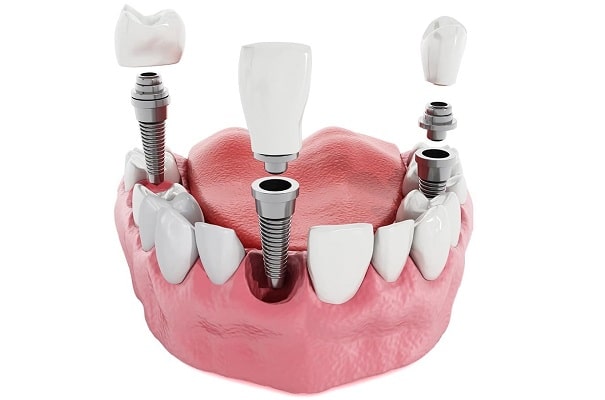
Conventional Implants
The conventional implant is a classic worldwide approach of Dental Implantologist procedure in which, after being screwed into the spongy bone (soft bone), the patient must wait for 3-5 months for osseointegration with the bone. Following this phase of osteointegration, the implant can be loaded with a crown or bridging framework.
With today’s breakthroughs in dental implant and bone grafting procedures, materials, and technology, nearly anyone with missing teeth can now benefit from dental implant treatments. Conventional implant procedures have a long track record of success. Additionally, due to advancements in implant technology and processes, quick implants and quick-loaded implants are now available, which can significantly minimize treatment time.
Phase 1:
The tooth is extracted and the implant is installed all in one visit. To ensure that there is adequate bone to sustain the implant, synthetic powdered bone material can sometimes be put into the unfilled extraction point. This is known as a socket graft or small bone graft. If there is insufficient bone in the upper jaw to support a molar or premolar implant, bone material is implanted in the extraction point and the sinus membrane is moved higher. This is known as a sinus lift. In most circumstances, extractions, implant insertion, and a socket graft or sinus lift could all be completed in one session. If major bone grafts (block grafts) are necessary, the implants might require an additional trip. A panoramic x-ray or CT scan can be used to determine this. The gums are sealed over the implant after it has been screwed into the jawbone. The implant must then osseointegrate with your jaw bone for 3-6 months before it is solid enough to sustain the abutment and crown. Although the implant can be placed in a single session, an initial consultation and diagnosis visit, as well as follow-up appointments for suture removal and post-operative check-ups, are needed.
Phase 2:
You will return when the implants have stabilized to get the abutment and crown placed. During this session, the gums are opened, the abutments are bonded to the implants, and impressions of the abutments and neighboring teeth are taken to be sent to the dental laboratory where the crowns are created. It is extremely important to take accurate impressions so that when the crowns are fitted, they fit perfectly, align and match the bite of your other teeth, and have a sufficient minimal margin at the gum line for the best appearance. The lab makes the crowns in a few days, and the entire procedure normally takes three sessions over the course of a week.
Conventional implants offer a long-term solution for lost teeth, restoring function and providing a natural, beautiful smile. Since the root of the tooth is also replaced, the implant tooth will look absolutely like a natural tooth, and the patient will be able to eat, drink, and speak normally. Implants are made of titanium, there is no risk of gum inflammation or interference with surrounding teeth. Conventional dental implants can help to prevent bone deterioration, which can occur following tooth loss or when a patient wears a denture for an extended period of time. conventional dental implant procedure is available in aurangabad at Dr. Changule face clinic
